Ellis,J. Pressure transients in water engineering, A guide to analysis and interpretation of behaviour
Подождите немного. Документ загружается.

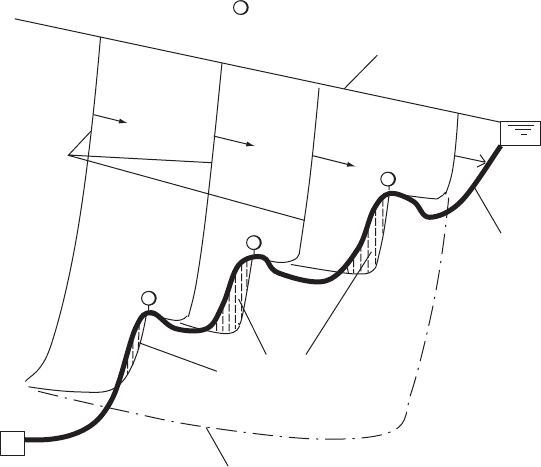
sources of fluid to supplement the reducing flow upstream of each valve.
Pressure transient alleviation has been accomplished around the air
valve and in the downstream section of pipeline. At the same time,
deceleration gradient has been increased along the upstream section
of main, above the value which would occur if the air valve were not
present.
In Fig. 17.6 an indication has been given of the possible position of
the minimum transient piezometric level along the main without air
valves being present. The influence of the air valves in alleviating the
worst sub-atmospheric pressures is evident.
17.3 Events following flow reversal
Some time after the initial downsurge, flow in the system will have come
to rest in a section of main between adjacent operating air valves. A
situation is developed where air pockets are present below each valve
which has functioned and piezometric level on each side of an air
valve will be close to the level of the air—water interface. If air
302
Minimum transient piezometric levels without air valves
(
i
g
norin
g
g
as release and
p
ossible column se
p
aration
)
PS
Zones of transient
sub-atmospheric pressure
Pipeline
profile
M
Successive positions
of pressure wavefront
Steady pumping hydraulic gradient
= air valve
Fig. 17.6. Illustration of pressure wave propagation with air valves
Pressure transients in water engineering
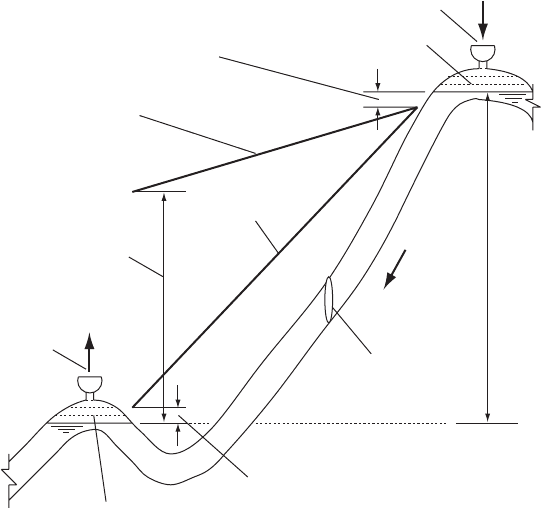
inflow/outflow has ceased at a valve then pressure will be atmospheric
within the air pocket below the valve. Residual pressure wave oscilla-
tions will usually be present in the sections of main between the air
pockets but for simplicity assume that these are negligible. The piezo-
metric line in the section of main between any pair of adjacent air
pockets will appear as shown in Fig. 17.7, with the liquid column
having just come to rest. The liquid in this part of the main is not in
equilibrium as there is an adverse hydraulic gradient between the air
pockets. Steepness of this gradient is a function of the difference in
elevation between the air pockets, head drop at inlet and outlet from
the air valves and the length of main between the valves. Magnitude
of this gradient can considerably exceed that of the steady-flow
hydraulic gradient where the pipeline is laid over undulating terrain.
Under the action of this adverse gradient, flow will develop from the
higher pocket to the lower with the upper air pocket tending to grow in
volume as air flows into the line through the upper valve while the lower
pocket reduces in volume as air is vented. With large-orifice air valves,
303
Head drop using small orifice
of lower air valve = K
out
V
2
/(2g)
M
M
Upper air valve with
large inflow capacity
Air pocket
Head drop through
upper air valve = K
in
V
2
/(2g)
Air pocket volume = Vol
Head drop using large orifice
of lower air valve = K
out
V
2
/(2g)
Pipeline diameter = D
and length = L
HGL using
large orifice at
lower air valve
Hydraulic grade line (HGL)
using small orifice
at lower air valve
Lower air valve
with air outflow
V+
DH
Fig. 17.7. Definition sketch for simple air valve analysis
Air valves
air outflow rates are substantial and the head loss through a valve will
remain relatively modest.
While the air valves may be instrumental in alleviating the initial
downsurge, in many instances the ‘secondary’ pressure transients
produced by closure of air valves can be more severe than the initial
downsurge after a pumping failure. This problem arises because of the
substantial hydraulic gradient which can develop between neighbouring
operating air valves where inflow/outflow of air is via a large orifice.
Only a modest differential head occurs across an operating air valve
while using this large orifice and so the air valve has little influence
on the development of reversed flow in the main.
Many air valves are also fitted with a second ‘small’ orifice valve
intended for venting of small accumulations of air under pressure.
Such modest quantities of air may enter the pipeline, through a pump
suction for instance, tending to accumulate at high points on a line
leading to an eventual decrease in overall efficiency of transmission.
Supposing that air outflow is only through the small orifice. Under
the initial adverse hydraulic gradient between two air pockets, flow
starts to develop towards the lower pocket and air begins to evacuate
through the small orifice of the lower air valve. As air outflow develops,
air pressure within the lower pocket increases and the volume of air
decreases due to compression as well as venting.
The rising head at the lower air pocket will cause hydraulic gradient
to flatten between the adjacent air pockets, since:
H
upper
H
lower
¼ head loss at valves
þ pipeline resistance between valves
þ inertial head
Head in the pipeline at the upper air valve will not drop significantly
below atmospheric pressure if the air pocket is increasing in volume as a
result of continued air inflow. If a still higher air valve is present further
downstream, it is possible that air may also be flowing out of the middle
air valve, in which case the head at this valve will also rise significantly.
In contrast with the earlier illustration when the large orifice was used
to discharge air at the lower valve, use of the small orifice restricts rates
of outflow and flattens the hydraulic gradient thus reducing head
available to accelerate flow and to overcome pipeline resistance.
Accordingly dV=dt is smaller and the eventual flow velocity when the
valve shuts is also limited. Upsurge after valve closure is correspondingly
lower because the differential velocity is smaller.
304
Pressure transients in water engineering

Velocities outwith the section of main under examination in Fig. 17.7
are assumed negligible. Also neglected is the deformation of air, water
and pipe wall. Rigid column theory can thus be applied.
The overall head difference between the air valves is made up of the
head drop as air flows into the line at the upper air valve; the head drop
as air exits from the pipeline through the lower air valve; minor losses
and resistance losses along the section of main; and inertial effects as
the water column accelerates towards the lower air valve. In the
absence of compression/expansion effects, volume flow through the
air valves will be of equal magnitude to pipeline flow.
The overall head difference H
upper
H
lower
¼ H can then be
written:
H ¼ L=g dV=dt þ FV
2
ð2:1Þ
where
FV
2
¼ fL=D þ
X
K
L
no
V
2
=ð2gÞð17:2Þ
where
P
K
L
is the sum of pipeline minor loss and inlet and outlet loss
coefficients at air valves. Rearranging equation (2.1) then:
dt ¼ L=fgðH FV
2
ÞgdV
from conservation of volume at the lower air valve:
dVol=dt ¼AV or dVol ¼AV dt
where pipe cross-section area A ¼ =4D
2
. Substituting for dt then:
dVol ¼LA=ðgHÞV dV=½1 F=ðHÞV
2
setting x ¼
p
fF=HgV, then V ¼
p
fH=Fgx and dV ¼
p
fH=Fgdx. The pipe volume ¼ LA ¼ Vol
p
. Substituting then:
dVol ¼Vol
p
=ðgFÞx dx=ð1 x
2
Þ
If z ¼ 1 x
2
therefore dz ¼2x dx,orx dx ¼
1
2
dz. Substituting
then:
dVol ¼ Vol
p
=ð2gFÞdz=z
Integrating
Vol ¼ Vol
p
=ð2gFÞlnðzÞþC
or
Vol ¼ Vol
p
=ð2gFÞlnð1 F=HV
2
ÞþC ð17:3Þ
305
Air valves
When Vol ¼ Vol
ðmaxÞ
(at time ¼ 0) then V ¼ 0 ( just as flow reverses)
so that:
Vol
ðmaxÞ
¼ Vol
p
=ð2gFÞlnð1ÞþC or C ¼ Vol
ðmaxÞ
then
Vol ¼ Vol
ðmaxÞ
þ Vol
p
=ð2gFÞlnð1 F=HV
2
Þð17:4Þ
When the lower air valve shuts, volume is reduced to zero and velo-
city has reached its maximum so that:
lnð1 F=HV
2
ðmaxÞ
Þ¼Vol
ðmaxÞ
=Vol
p
fL=D þ
X
K
L
or
1 F=HV
2
ðmaxÞ
¼ exp Vol
ðmaxÞ
=Vol
p
fL=D þ
X
K
L
hi
Finally,
V
ðmaxÞ
¼
p
2gH= fL=D þ
X
K
L
n
1 exp Vol
ðmaxÞ
=Vol
p
fL=D þ
X
K
L
hio
ð17:5aÞ
If Vol
ðmaxÞ
!1,
V
ðmaxÞ
!
p
2gH= fL=D þ
X
K
L
no
ð17:5bÞ
Equation (17.5b) is the result to be expected when an equilibrium
condition has been reached. Equation (17.5a) shows that velocity
developed in a section of main is dependent upon the length, gradient
and size of air pockets. Where piezometric gradient between air valves is
large and air pockets are similarly large then there may be time for
velocity to achieve a maximum value where the difference in piezo-
metric levels is entirely absorbed in overcoming pipeline resistance
and also head losses at the adjacent air valves, equation (17.5b).
When air pockets are small and gradients are lower there may be
insufficient time for equilibrium to be attained and velocities will be
smaller than that given by equation (17.5b).
For a hypothetical section of main, length ¼1000 m and dia-
meter ¼1000 mm, friction factor f ¼ 0:02 and with a 10 m overall
head difference between the upper and lower air valves, plotting
V
ðmaxÞ
as a function of initial air volume Vol
ðmaxÞ
for different values
of the parameter
P
K
L
=ðfL=DÞ then the curves of Fig. 17.8 were
obtained. These curves demonstrate that as air pocket volume is
306
Pressure transients in water engineering
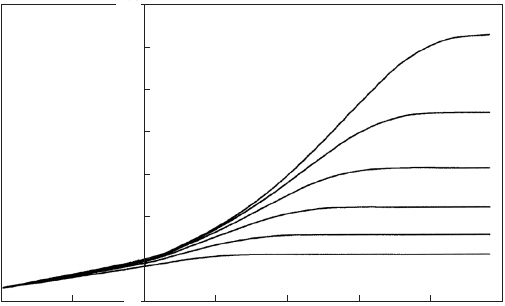
increased, the time available to accelerate the reversed flow is also
increased, leading to an increased velocity when the valve finally
shuts. With a small air pocket, limited time is available for acceleration
and so final velocity remains low. As overall system resistance is
increased, the remaining head available to accelerate the reversed
flow is lower and the final velocity is also reduced. Clearly, for a
given system pipeline, resistance is fixed and so the only available
means of increasing overall system resistance is by adjusting the air
flow characteristic of the air valve. The results of this ‘rigid column’
analysis become more approximate as resistance is increased. As head
drop through the lower air valve rises with greater resistance to flow
through the orifice, the pressure within the air pocket is increased
and compression of the air mass becomes more important. Volume
flow rate through the air valve can no longer be approximated to pipe-
line flow. This aspect will be considered in Chapter 18. Figure 17.8 has
served to demonstrate that throttling of air outflow has the effect of
limiting reversed velocity. This finding has been used to produce air
valves which permit a large air inflow rate but which impose an
increased resistance during air outflow. The vented non-return attach-
ment for the Glenfield ‘APEX/EPEX’ valve employs this principle.
Other manufacturers also provide this option.
307
0.1 0.316 1.0 3.16 10.0 31.6 100.0 316.0
Maximum velocity when
the air valve shuts (m/s)
V
(max)
3.5
3
2.5
2
1.5
1
0.5
0
0
1
3
7
15
31
Maximum air volume, Vol
(max)
(m
3
)
V
(max)
= ÷{2gDH/(fL/D + SK
L
)(1 – exp[–Vol
(max)
/Vol
p
(fL/D + SK
L
)])}
DH = 10 m; L = 1000 m; D = 1000 mm; f = 0.02; Vol
p
= pD
2
L/4
SK
L
/(fL/D)
Fig. 17.8. Maximum reversed velocity plotted against initial air volume at ai r
valve
Air valves

17.4 Air valve closure
The importance of the velocity developed while air is being vented at an
air valve is demonstrated by events subsequent to closure of the valve
on completion of air removal. During the process of air venting, a
difference in flow rate will develop in the sections of pipeline upstream
and downstream of the valve. At the instant when the air volume is
completely removed and the air valve shuts, differential flow across
the air valve connection is abruptly eliminated.
Figure 17.9(a) shows an air valve located in a section of pipeline.
Immediately before valve closure:
V
u=s
þ g=a
u=s
H
o
¼ Jþ and V
d=s
g=a
d=s
H
o
¼ J
where V
u=s
, V
d=s
and H
o
represent flow conditions just before valve
closure. Just after the air valve shuts:
V þ g=a
u=s
H ¼ Jþ and V g=a
d=s
H ¼ J
or
H ¼ 1=gðJþJÞ=ð1=a
u=s
þ 1=a
d=s
Þ
and
V ¼ða
u=s
Jþþa
d=s
JÞ=ða
u=s
þ a
d=s
Þð17:6aÞ
where V and H represent velocity and total head in the pipeline at the
air valve connection. Substituting for Jþ and J then:
H ¼ 1=gðV
u=s
V
d=s
Þ=ð1=a
u=s
þ 1=a
d=s
ÞþH
o
and
V ¼ðV
u=s
a
u=s
þ V
d=s
a
d=s
Þ=ða
u=s
þ a
d=s
Þð17:6bÞ
Where acoustic velocities upstream and downstream of the valve are
the same, equations (17.6b) reduces to:
H ¼ a=ð2gÞðV
u=s
V
d=s
ÞþH
o
and V ¼
1
2
ðV
u=s
þ V
d=s
Þð17:6cÞ
The abrupt upsurge produced by closure of the air valve is dependent
upon the strength of the differential velocity V
u=s
V
d=s
just before
valve closure. Suppose in a pipeline the acoustic wavespeed upstream
and downstream of the air valve is 1000 m/s and the differential velocity
V
u=s
V
d=s
¼ 1:0 m/s. If venting is through the large orifice then
pressure head in the pipeline below the air valve will be close to
atmospheric. The head rise H H
o
on valve closure will be:
H H
o
¼ 1000:0=ð2 9:81Þ1:0 ¼ 51 m
308
Pressure transients in water engineering
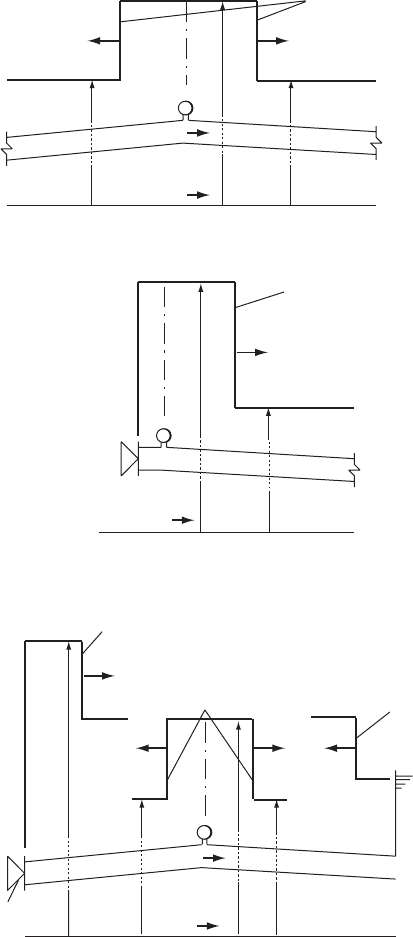
309
Common horizontal datum
(a)
Wave fronts after
closure of air valv
e
V + a
H
o
H
o
H
V – a
+x
V
Air valve
Common horizontal datum
(b)
V + a
H
o
H
+x
V = 0
Wave front after air valve
closure at shut valve
Shut valve, e.g. NRV
Common horizontal datum
(c)
V + a
V + a
V – a
V – a
H
o
H
o
H
r
H
+x
V
V = 0
Shut valve,
e.g. NRV
Wave front produced on
reflection from shut valve
Wave front on reflection
from air pocket, tank
or reservoir
Pressure wave
fronts produced by
air valve closure
M
Fig. 17.9. Head conditions (a) and (b) just after air valve closure and (c) as
pressure waves are reflected
Air valves
Suppose the air valve is just downstream of a shut valve, such as the
check valve at a pumping station (Fig. 17.9b). A single characteristic
will arrive at the air valve connection at the moment of closure, then:
J¼V
d=s
g=aH
o
Just after valve closure, velocity ¼ 0 and head will be H , so that:
0 g=aH ¼ J¼V
d=s
g=aH
o
giving
H ¼ H
o
aV
d=s
=g ð17:7Þ
Considering a wavespeed of 1000 m/s and a reversed velocity
V
d=s
¼1:0 m/s then the head rise after valve closure will be:
H H
o
¼1000:0 ð1:0Þ=9:81 ¼ 102 m
This is double the amplitude of the head rise at an air valve located
along a pipeline. For a valve along the pipeline, the abrupt pressure
rise after air valve closure will propagate both upstream and downstream
from the now closed valve as compression waves (Fig. 17.9c), thus
affecting adjacent sections of main. Subsequently the pressure waves
will be reflected from closed check valves, other still-existing air pockets
and discharge points to tanks and reservoirs. The result can be a
complicated pattern of hydraulic transient behaviour in the pipeline
as a whole.
17.5 Case study of a sewage pumping station
Wave reflections of a pressure wave produced by an air valve closure
can cause that valve, and other neighbouring valves, to reopen and
close several times. Consider a relatively straightforward sewage
pumping scheme in the State of Qatar whose pipeline profile is
shown in Fig. 17.10. Pumping failure was predicted to open air valves
at the pumping station and at chainage 2.19 km along the pipeline.
Vacuum pressures were anticipated over almost the entire main with
an air pocket in the pipeline around chainage 2.19 km. Subsequent
closure of this air valve after a period of venting through the large orifice
produced peak transient piezometric levels of þ70 mHSD.
The variation of air volume contained in the pipeline at the pumping
station is shown in Fig. 17.11. The valve initially opens when head falls
after pumping failure. The subsequent period of air admission occurs as
a consequence of pressure wave reflections following closure of air
310
Pressure transients in water engineering
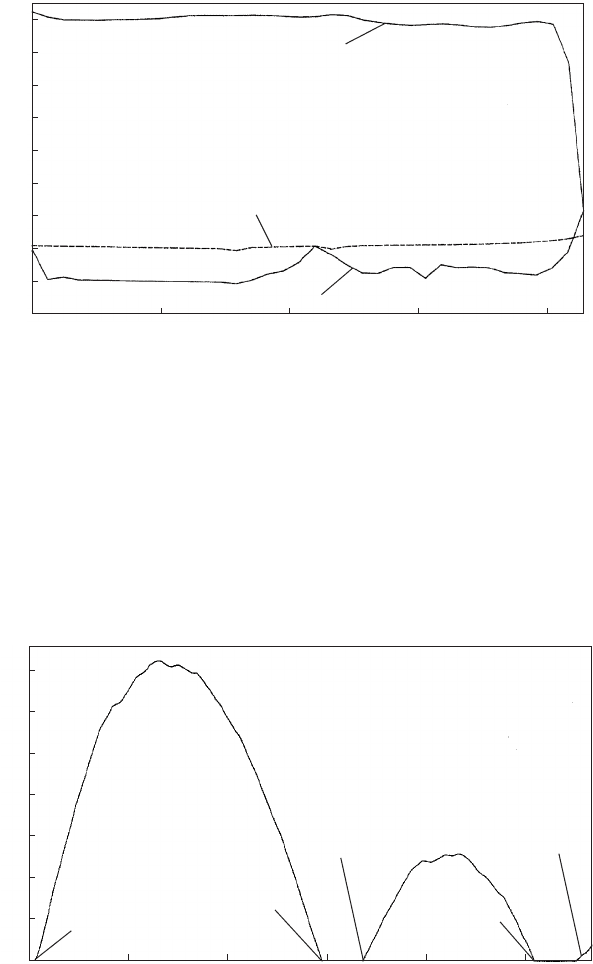
valves when the first air mass has been expelled. Air volume variation at
chainage 2.19 km is more complicated with the air valve opening and
closing repeatedly (Fig. 17.12). Transient head variation at the
pumping station (Fig. 17.13) shows the initial fall in head after trip
followed by a long interval during which air first flows into the line
and then is removed from the pipeline, culminating in an abrupt
311
1 2 3 4
Elevation (mHSD)
Chaina
g
e (km)
Envelope curves of maximum and minimum head along the rising main
70
60
50
40
30
20
10
0
–10
Minimum piezometric level
Maximum piezometric level
Pipeline profile
Fig. 17.10. Envelope curves with large-orifice air valve operating
Air valve opens
Air valve opens
Air valve shuts
Air valve shuts
3500
3000
2500
2000
1500
1000
500
Air volume (l)
Time
(
min
)
Air volume variation at pumping station air valve
0.5 1.0 1.5 2.0 2.5
Air valve opens
Fig. 17.11. Air volume variation at PS air valve after pump failure
Air valves
